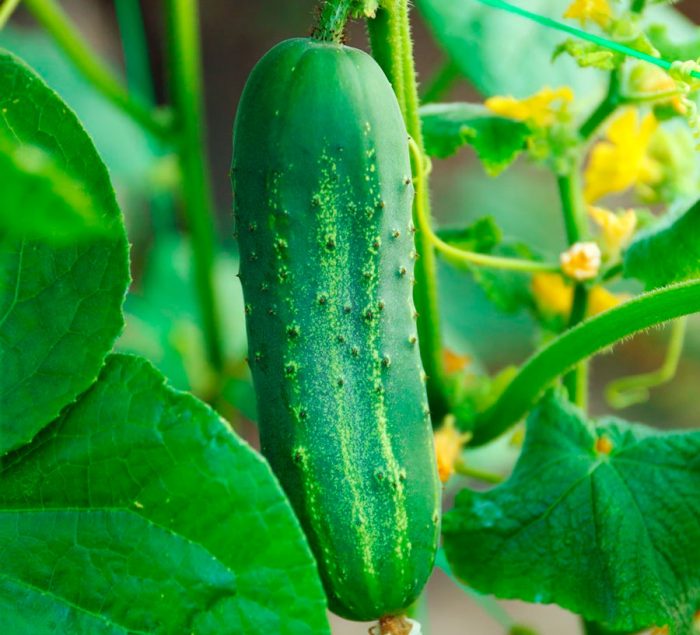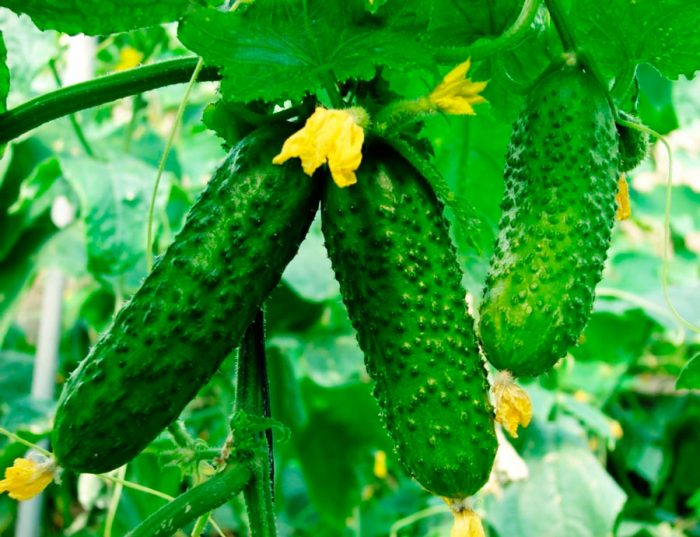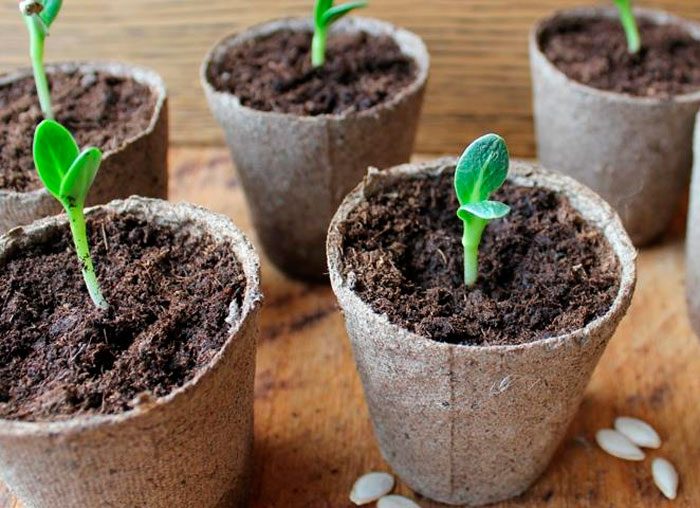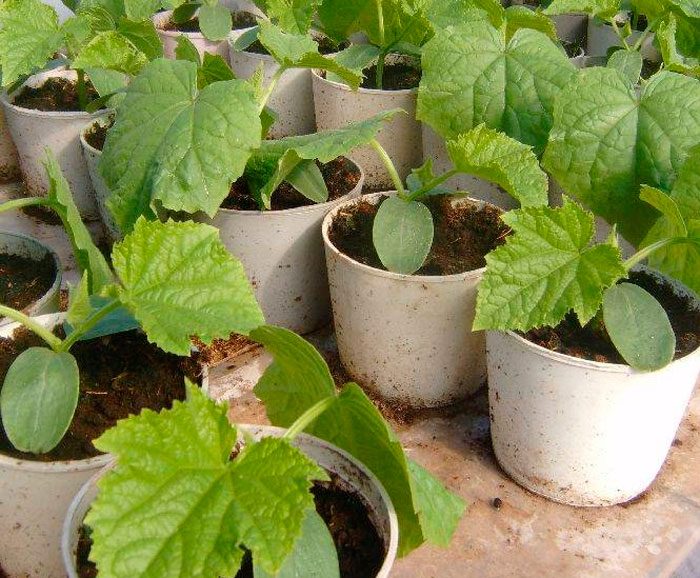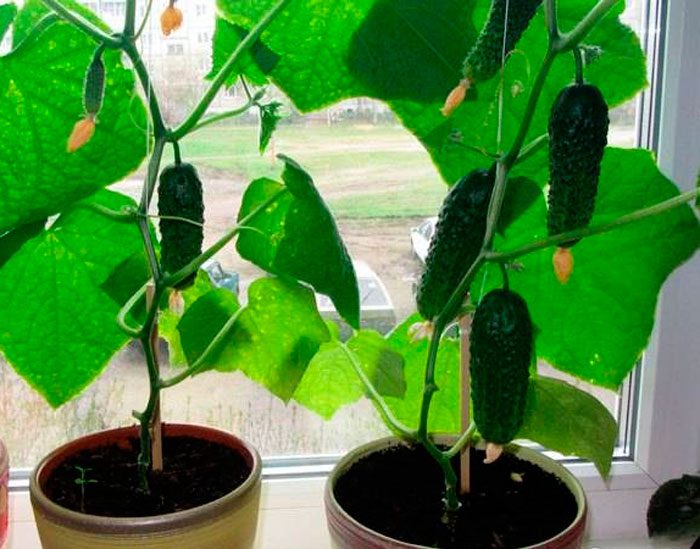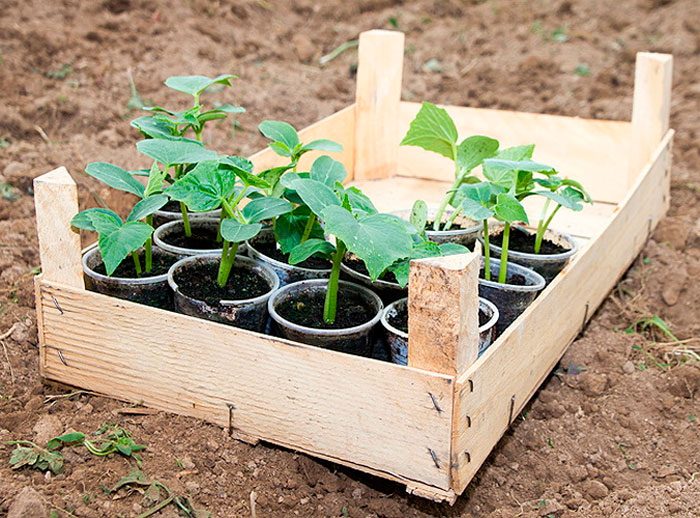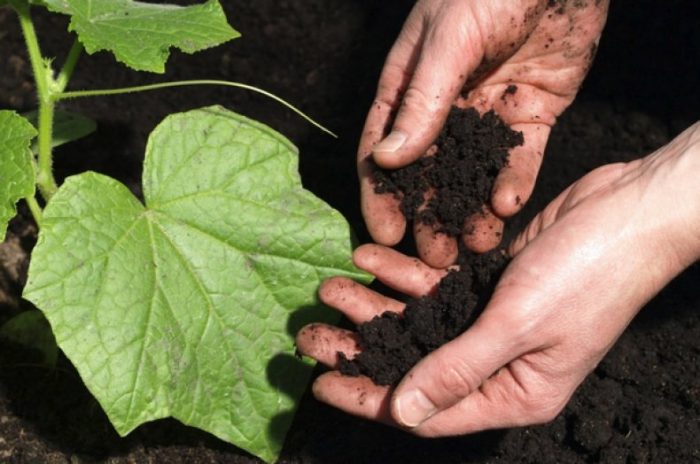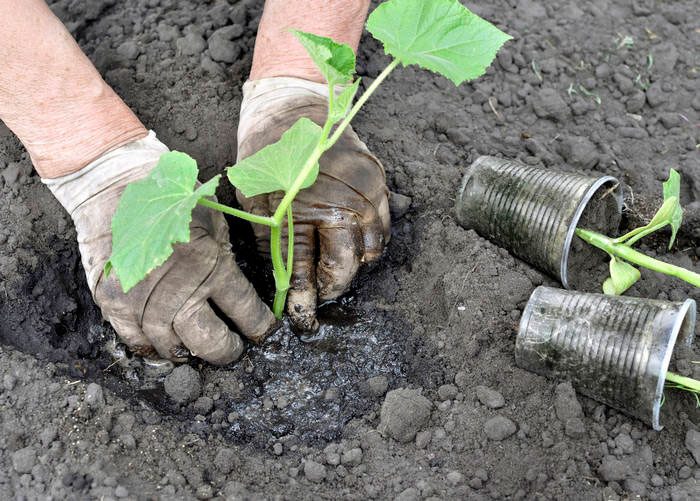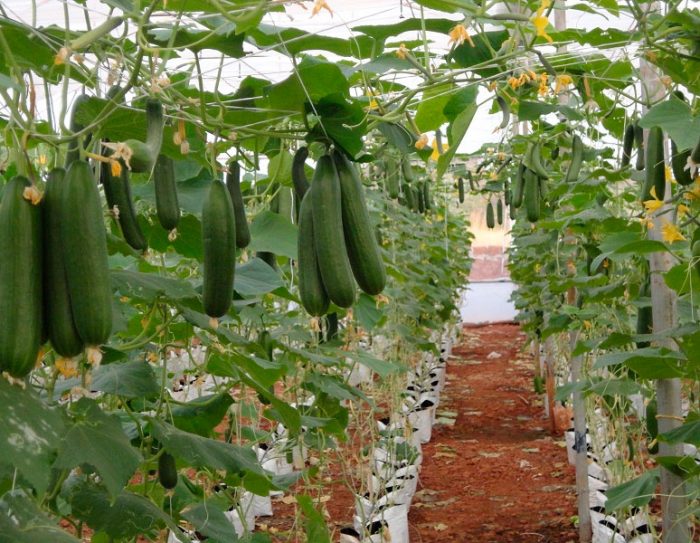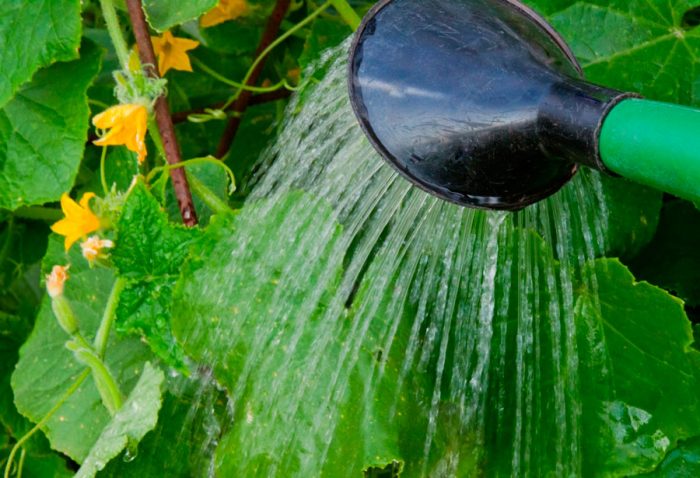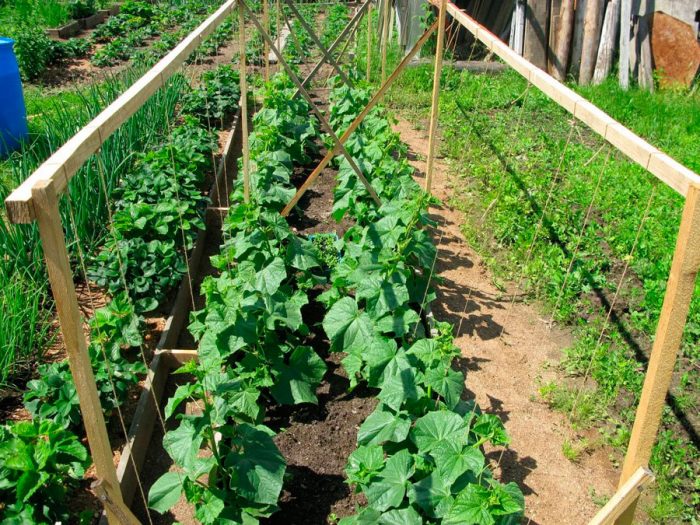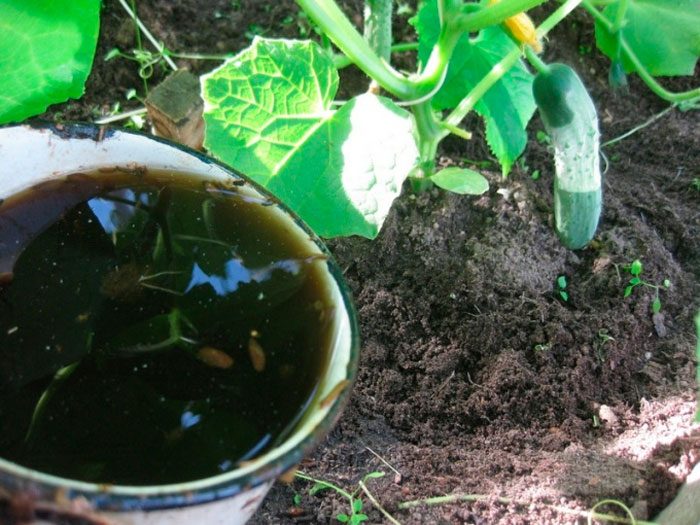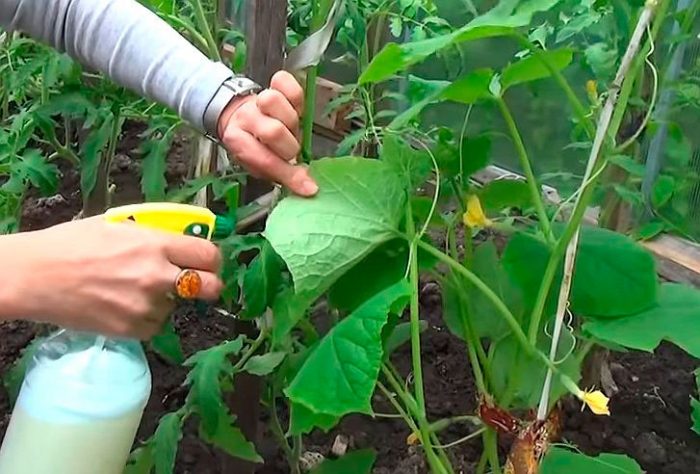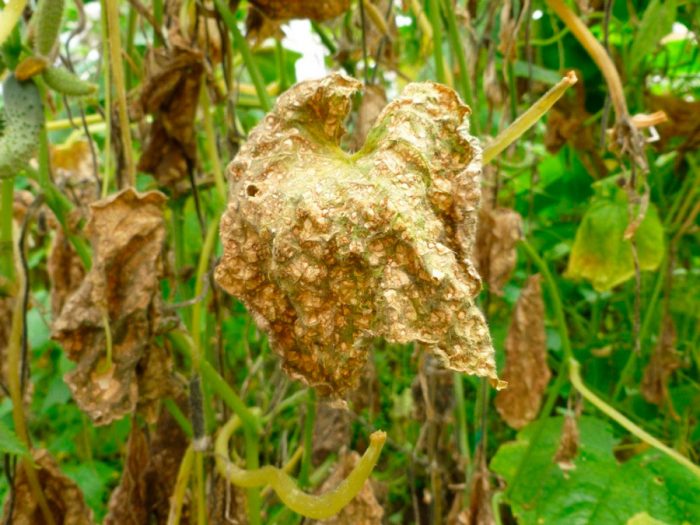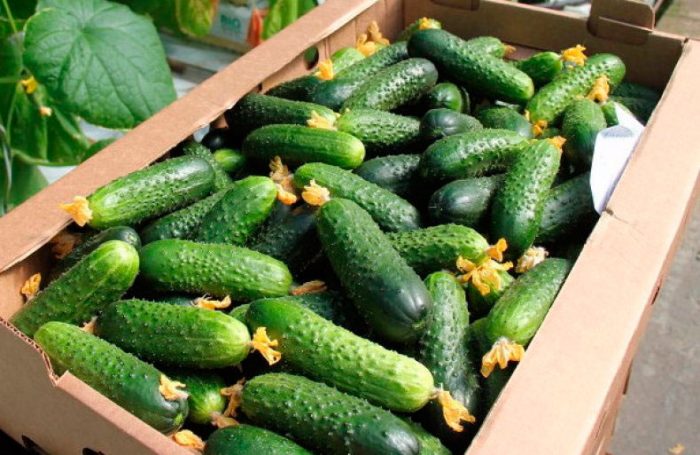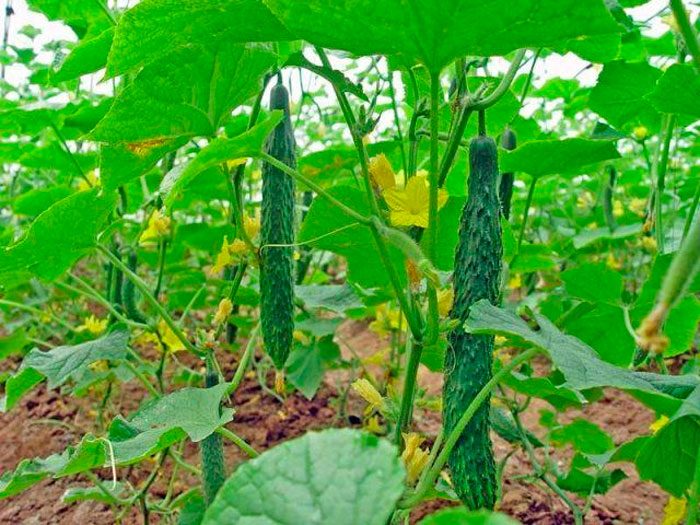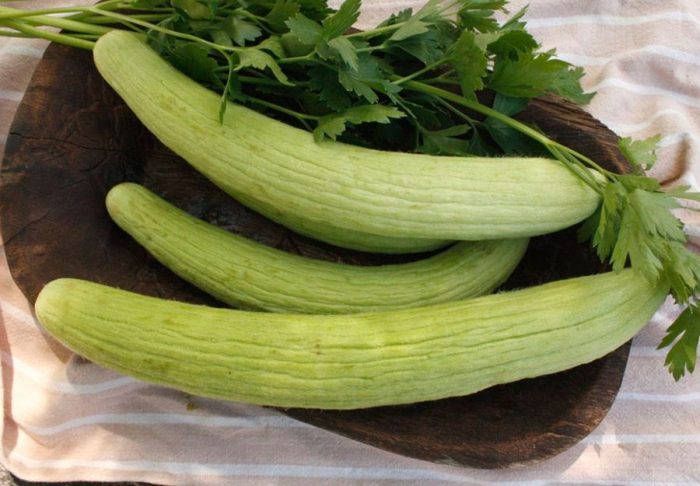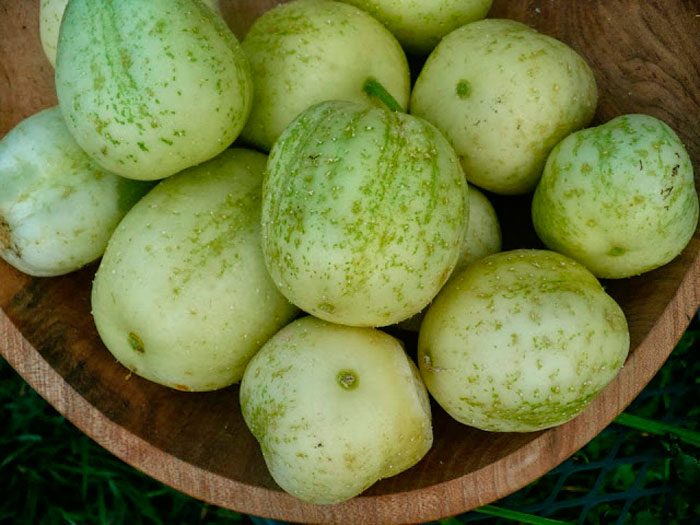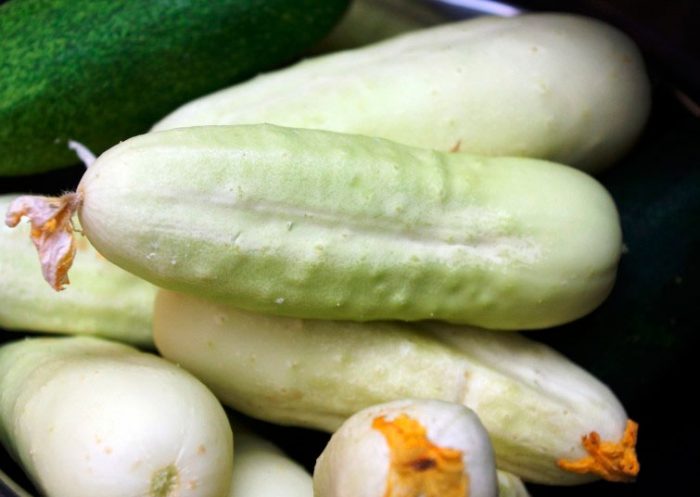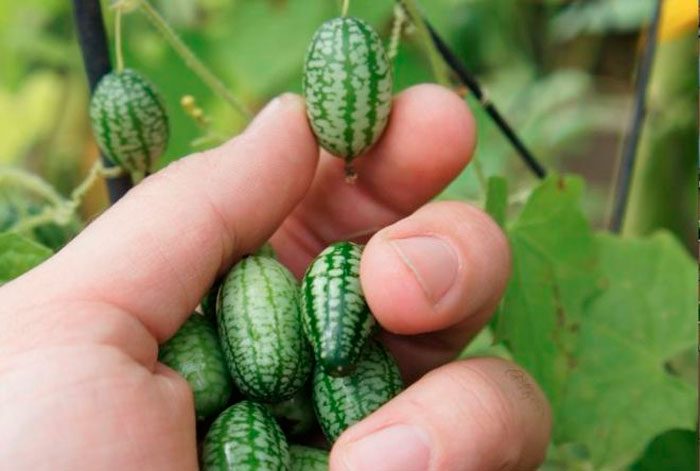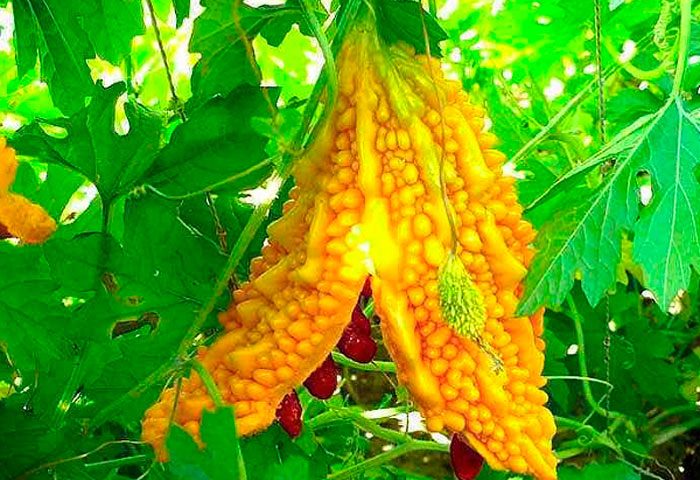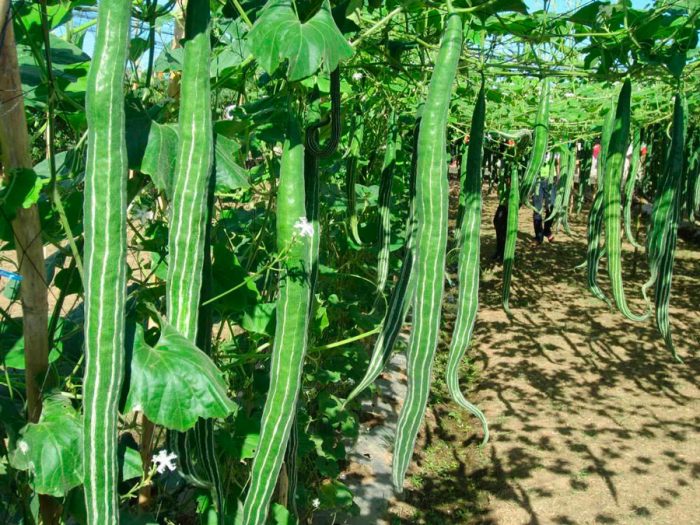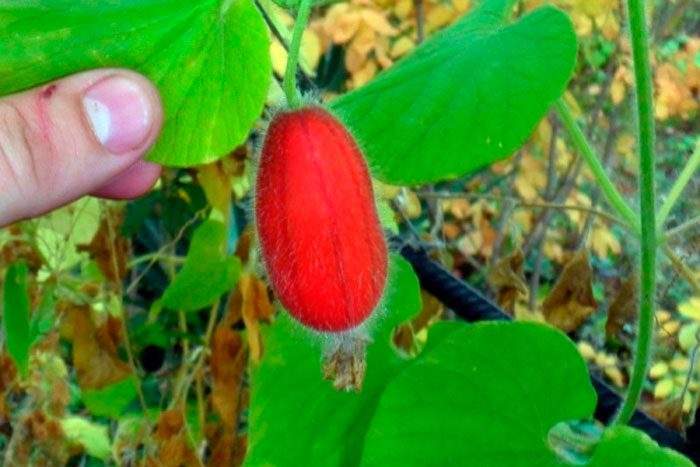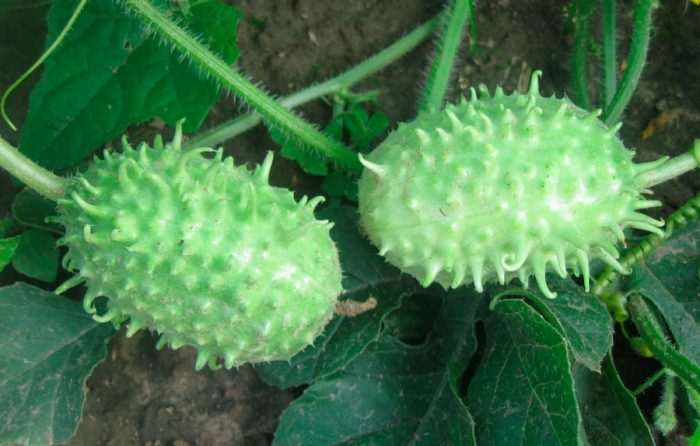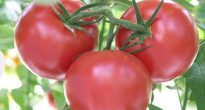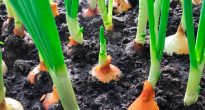The herbaceous annual cucumber or common cucumber (Cucumis sativus) is a species of the genus Cucumber of the Pumpkin family. This vegetable crop is very popular with gardeners all over the world. The name of this type comes from the Greek word "aguros", which translates as "immature". At the etymological level behind this name is the notion that the fruits of such a plant are eaten in a green unripe form, for example, in comparison with tomatoes that are not eaten unripe. This plant has been cultivated for more than 6 thousand years. The homeland of this species is India, today this culture is still found in the wild at the foot of the Himalayas. There is a mention of the cucumber in the Bible, it is called there “the vegetable of Egypt”. This culture was grown first by the ancient Greeks, then by the Romans, in Central Europe, cucumbers became very popular during the time of Charlemagne. In Russia, this culture was grown already in 1528, this became known from the notes of the German ambassador to the Moscow state Herberstein.
Content
Features of cucumber
The creeping rough shoots of cucumbers are about 200 cm long, which end in a mustache, they catch on to the support. Five-bladed leaf plates are heart-shaped. The juicy, bubbly, polyspermous fruit has an emerald green color, its structure is typical for the Pumpkin. The varieties differ in the size and shape of the fruit. They are 95 percent water, and they also contain the following trace elements useful for the human body: iron, magnesium, phosphorus, calcium and vitamins - C, B1, B2, provitamin A. The juice of this fruit is considered a structured liquid that removes toxins well and toxins and has a beneficial effect on the human body. Such fruits contain iodine in compounds that are easily absorbed by the body.
Growing cucumbers from seeds
Sowing rules
If cucumbers are grown through seedlings, then after transplanting into open soil, they will begin to bear fruit half a month earlier, and fruiting will end later. Sowing of cucumbers for seedlings is carried out in April. If the seeds are stored correctly, they remain viable for 8-10 years, but the highest yield is the seed that is 3 or 4 years old.
For sowing, only large, full-weight seeds are suitable, which for 4 weeks should be near the heating devices in the place where the temperature is approximately 25 degrees. If the seeds are hybrid varieties, then they do not need to be heated. Also, disinfection of seeds should be included in the pre-sowing preparation of seeds. For this, the seeds are needed for 60 minutes dip in an infusion consisting of 30 grams of garlic pulp and 100 grams of water. The disinfected seed must be placed in a moistened tissue for swelling, so they should lie for two days in a warm place at a temperature of about 20 degrees. Then they are removed for 2 days on the refrigerator shelf intended for vegetables.
Sowing the prepared seeds should be carried out in plastic cups or peat pots, the height of which should be from 10 to 12 centimeters. The cups must be filled with a soil mixture consisting of sawdust, humus or peat (1: 2: 2). 10 liters of such a substrate must be combined with 1.5 tbsp. l. nitrophoska and 2 tbsp. l. wood ash. In 1 glass you need to put one seed, which should hatch by this time. When sowing, the seed must be placed with its spout upwards, then during germination the peel from the seed will remain in the substrate. The seed does not need deep planting, they need to be covered with only a thin layer of substrate, the thickness of which should be from 0.5 to 1 cm.Then the substrate is carefully moistened, and its surface is covered from above with a paper sheet, after which the crops are removed to a warm place (from 22 up to 28 degrees). Seedlings can be transplanted into open soil after 20-30 days. If the seeds were sown in peat tablets or peat pots, reaching from 41 to 44 centimeters in diameter, in this case they can be planted in the hole together with the container, the fact is that cucumbers react extremely negatively to transplantation.
How to care for seedlings
Seedlings of cucumbers must be watered, fed and dived in a timely manner (when grown in a common container). Such seedlings need artificial lighting. After the seedlings appear, they will need to be rearranged to a cooler place: from 20 to 22 degrees in the daytime and from 15 to 16 degrees at night. Plants will need additional lighting, for this they use agro-lamps or fluorescent lamps, in which case the seedlings will not stretch.
During the formation of 2 true leaf plates in cucumbers, they must be fed, for this, a nutrient mixture must be added to the substrate, consisting of 1 liter of cool water (about 20 degrees), in which 1 tsp must be dissolved. nitroammophos. 1-2 days before transplanting cucumbers into open soil, they should be fed with a nutrient mixture consisting of 1 bucket of water, 10 grams of potassium fertilizer, 15 grams of urea and 40 grams of superphosphate. This volume of the mixture is enough for a couple of square meters of land.
It is necessary to water the seedlings correctly, while this procedure is carried out only once every 7 days. Cucumbers are watered very abundantly, and then the excess liquid must be drained. For this reason, the cups are recommended to be placed on a pallet. If the plants are growing rapidly, but transplanting is not planned in the near future, then if necessary, add a little substrate to the container, as a result the plants will become more resistant.
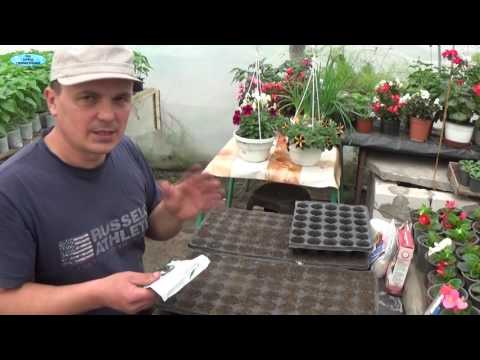

Watch this video on YouTube
Pick rules
As mentioned above, such a plant reacts extremely negatively to transplanting and picking, in this regard, experienced gardeners recommend choosing peat-peat cups or tablets for growing such seedlings. If the seedlings grow in a common container, then they must be dived, they do this during the formation of 2 true leaf plates in the plants. Before you start picking, the seedlings should be watered abundantly, only then the plants are carefully pulled out, while trying to leave the earth on the roots. Then the seedling is planted in an individual container, while the root system and part of the shoot must be buried in the substrate. For this, a deepening is made in the soil mixture so that, when planting, the seedling is immersed in it in cotyledonous lobes. Around the planted plant, the substrate should be compacted very well, as a result it should not be easy to pull it out of the soil. During the pick, diseased and curved specimens should be discarded. You also need to remember that this procedure helps to delay the development of cucumbers for 5-7 days. Under suitable weather conditions, well-developed seedlings can be dived directly into open soil at once to a permanent place. Or, it is recommended to pick plants in peat cups, then after the time comes, the seedlings can be transplanted to a permanent place in open ground together with the container.
The hardening of cucumbers is started 7 days before they are transplanted into open soil. To do this, the seedlings must be transferred outside for several hours every day, while at first they need protection from gusts of wind and drafts. Even before proceeding with planting, it is recommended to spray the plant with a solution of Epin or Immunocytophyte for prophylaxis.
Growing cucumbers at home
Cucumbers can also be grown in room conditions, while varieties that do not need pollination are used for sowing, so it is easiest to place medium-sized or bush cucumbers on the windowsill. Well at home, such hybrids as: Claudia and Marinda, as well as varieties: Domashny, Rytova, Masha, Komnatny, Marfinsky, Bianka, grow.
To get a harvest of fresh cucumbers for the New Year, you should start sowing seeds in the last days of October, and if they are needed by March 8, then sowing should be done in January. From the moment the first shoots appear and until the first fruits ripen, it usually takes 45 to 50 days.
Cucumber seeds require pre-sowing preparation. To do this, they need to be disinfected in a weak solution of manganese potassium of pink color, the seeds are kept in it for 15 to 20 minutes. Then the seed should be rinsed in running water.
The prepared seeds are laid out in separate cups, reaching 60–80 mm in diameter. A layer of expanded clay or coarse-grained sand should be placed in an empty glass on the bottom, then they are filled with a light substrate saturated with nutrients, which must be combined with rotted organic matter. Experts advise, in this case, to buy a substrate specially designed for cucumber seedlings. When the cups are full, the soil mixture in them will need to be spilled with freshly boiled water. When the ground cools down, prepared seeds must be placed on its surface, they are covered with a piece of moistened gauze on top, and then the containers are transferred to the windowsill located in the eastern or southern part of the room. Crops need to be provided with an air temperature of 22 to 26 degrees in the daytime, and from 17 to 22 degrees at night, while they need protection from drafts. The gauze covering the seeds should be kept in a moist substrate at all times.
A few days later, sprouts should grow on the seeds in the containers, after which a hole should be made in the middle of the glass, reaching a depth of 10 mm.A seed is placed in it, which is sprinkled on top with a thin layer of soil. Cover the container on top with a film or a sheet of paper to prevent excessive evaporation of moisture. As soon as the seedlings appear, the shelter must be removed. So that they do not stretch, they need to provide additional illumination, but if this is not possible, then the cucumbers must be placed in a cooler place: from 13 to 15 degrees at night and from 15 to 17 degrees during the day.
The plant should be watered in a timely manner, do this after the top layer of the substrate dries. Seedlings during the formation of the third real plate, they should be dived one by one into individual containers, which should be spacious enough; for this, you can use buckets or pots, reaching about 25 centimeters in diameter. The pick should be carried out on a cloudy day, then the plant must be protected from direct sunlight for two or three days. After finding the first ovaries, the plants should be fed; for this, an infusion of ash is used. To prepare it, you will need 1 liter of hot water and 100 grams of wood ash, the mixture should be infused for 24 hours, then it is used to water the soil in containers.
After the lateral processes grow on the central lash, it is necessary to pinch them. One bush should have no more than two lashes, while they need a mandatory garter. It is best to use a coarse-mesh construction mesh as a support, which must be pulled over the window; as it grows, the whips will catch on with antennae. Watering should be done after the top layer of the substrate dries out, this procedure is performed in the early morning or in the evening, while using lukewarm water with a temperature of 27 to 30 degrees. It is extremely important to water such a culture correctly, since stagnant water in the soil can lead to rotting of the root system, if the bushes lack moisture, then the cucumbers will have a bitter taste.
After the appearance of the fruits, their overgrowth should not be allowed, and then the formation and development of the following cucumbers will occur much faster.
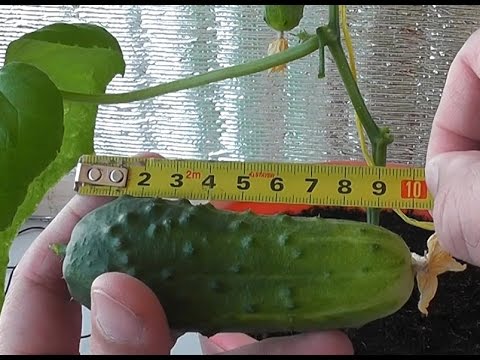

Watch this video on YouTube
Planting cucumbers in open ground
What time to plant
Planting cucumber seedlings in open soil should be done only after it has grown at least 3 or 4 true leaf plates, while the soil should warm up to a temperature of 20-24 degrees, and warm weather should also be established. As a rule, the time for planting cucumbers in open soil falls on the second half of May.
To grow this crop, you must choose a sunny area, but you can plant cucumbers in a shaded place, and it must also have reliable protection from gusts of wind. If there is a threat of frost at night or a rapid cold snap, the transplanted seedlings must be covered with a film, while metal arches must be installed throughout the bed, and covering material should be thrown over them. Even directly next to the holes along the bed, it is necessary to dig in a coarse mesh or install a trellis, it is along it that the cucumber shoots will climb up.
Suitable soil
A well-drained soil with a high nutrient content and little nitrogen is suitable for growing cucumbers. If the soil is acidic, then it must be limed before planting cucumbers. In general, this culture can grow on any soil, but a substrate consisting of humus, sod land, peat and sawdust, which is taken in a ratio (1: 1: 6: 1), is best suited. It is important that the soil is well warmed up and loose. That is why for such a plant it is necessary to make high beds, the height of which should be about 25 centimeters.The beds should be directed from east to west, while they should not have a very large slope to the south. 24 hours before planting the seedlings, the made bed must be shed with a solution of copper sulfate (1 tsp of the substance is taken for 1 bucket of very hot water). For 1 square meter of the site, 3 liters of such a mixture are used. Cucumbers should not be grown in the area where watermelons, zucchini, lagenaria, pumpkin, melon, zucchini and other members of the Pumpkin family were previously grown. Tomatoes, cabbage, green manures or onions are good predecessors for such a crop.
Disembarkation rules
Since the root system of such a plant is unbranched, the nutrient mixture must be applied during transplanting. To do this, it is necessary to make holes in the beds, the depth of which should be about 0.4 m, and a distance of 0.6 m should be maintained between them. A layer of soil should be poured into the hole, which must be mixed with humus or compost. After that, nutrient soil not mixed with fertilizer is poured into it. Seedlings need to be planted together with a lump of earth, or the plant is placed in the hole along with a peat pot. The hole should be covered with soil, and then watering is carried out, while taking 3 liters of water for 1 bush. Then, if necessary, the surface of the bed should be covered with a layer of mulch (cut grass or peat), it is able to attract earthworms to the site, which can enrich the soil with humus. If desired, instead of this, the surface between the rows can be covered with a black ground cover material, this will reduce the amount of moisture evaporated from the top layer of the soil, as well as slightly increase the temperature of the substrate.


Watch this video on YouTube
Growing cucumbers in a greenhouse
To get early cucumbers, they should be grown in a greenhouse, for this it is recommended to use hybrids intended for indoor use, for example: Ant, Marinda, Twixy, Halley, Murashko, Bidretta and Buyan. In order for the cucumbers to grow very early, it is recommended to make compost beds in the greenhouse, called "warm", or dung beds - "hot". If there is fresh cow dung, it is necessary to lay out a high bed in the greenhouse from it. It must be covered with a layer of nutritious soil on top, the thickness of which must be at least 25 centimeters. The soil should be watered very well, then seeds are distributed on its surface, while there should be 4 pieces per 1 square meter of the plot, no more. When sowing hybrids, seeds should not be prepared. They need to be buried in the soil only 10–20 mm, then support arches are installed on the garden bed, and light-colored covering material must be laid on top of them. Since manure warms up the soil well, the first seedlings should appear in about three or four days. In the daytime, the cucumbers need to be ventilated, for this you need to raise the shelter for a while.
It is necessary to monitor the temperature of the air and soil in the greenhouse, the fact is that it can change greatly with the weather. In order for the plant to grow and develop normally, they need an air temperature of 18 to 30 degrees. If the greenhouse is warmer than 30 degrees, this will lead to the fact that the bushes will burn. The cucumbers in the greenhouse may also need additional lighting.
In the absence of manure, a garden bed in a greenhouse can be folded from garden compost. Since the soil on the garden bed in this case will not be very warm, it is recommended to use sprouted seeds for sowing, they must be planted directly in peat tablets or cups. In areas with a cold climate, it is recommended to make beds of manure in the greenhouse, in regions with a relatively warm climate, beds of compost are also suitable. In the future, cucumber bushes should be looked after in the same way as those grown in the open field.
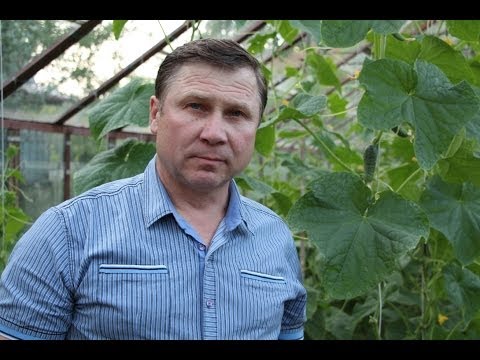

Watch this video on YouTube
Cucumber care
The first days after transplanting cucumber seedlings into open soil, they must be often watered, as well as shaded from direct sunlight. During a severe cold snap, the cucumbers will need to be covered. It should be noted that when the temperature drops to 15 degrees, the bushes begin to grow more slowly, at temperatures less than 10 degrees they stop developing altogether. When the bushes are watered, it is recommended to loosen the surface of the soil in the holes, as well as to huddle the plants themselves, but this should be done very carefully, since their root system is located in the upper layer of the earth. If the site is mulched, then this will reduce the number of loosening, weeding, and watering. When growing in open soil, it is recommended to pinch the bushes over a 5 or 6 leaf plate, this will lead to stimulation of the growth of lateral lashes.
How to water
Before the bushes begin to bloom, they should be irrigated once every 5–7 days, while for 1 square meter of the plot, it is necessary to take 3–6 liters of water. After the cucumbers bloom, their watering should become more frequent, namely, once every 2-3 days, while the amount of water should be increased to 6-12 liters per 1 square meter of the plot. It is necessary to water the bushes with lukewarm (about 25 degrees) well-settled water, this should be done in the early morning or in the evening. In the case when the liquid is poorly absorbed into the soil, its surface between the rows must be pierced with a pitchfork to a depth of 10 to 15 centimeters, the water should wet the ground to a depth of 20 to 30 centimeters.
Water should be poured under the root, while trying to prevent it from falling on the surface of the leaf plates. In order to prevent soil erosion by a stream of water and exposure of the root system, a watering can with a splitter should be used for irrigation. Watering is very important for such a crop; plants should be watered in such a way that the water in the soil does not stagnate, because this leads to the development of fungal diseases. If the bushes feel a lack of liquid, then the fruits will have a bitter taste. In this regard, watering should be carried out only when necessary.
How to tie cucumbers
This crop should be grown in open soil in two ways: vertical or horizontal. There are several vertical garter methods, some of which are exotic and quite witty. For example, bushes can be grown in polyethylene bags, under a black film, in holey barrels or in a hut.
Since this plant is a liana, it must be tied up. This procedure helps to save space, make it easier to collect fruits, as well as prevent the development of certain diseases. During the formation of 3 or 4 of a real leaf plate, the bushes must begin to be tied to a support, as a rule, they do this almost immediately after transplanting cucumber seedlings into open soil.
You can also tie up the bushes vertically and horizontally. With the horizontal method of garter, at the end and at the beginning of the row, it is necessary to install columns, reaching a height of about 2 meters, between them you should pull several rows of wire or rope, which must be very strong, it is along them that the growing whips will rise. With the vertical garter method, a structure in the shape of the letter P is installed on the garden bed. To create it, 2 powerful vertical supports are dug into the ground, a wire is pulled between their upper points, it is to it that ropes should be tied that will wrap around the shoots of bushes. These ropes should be pulled up as the shoots grow, but they should not be pulled very tightly. Instead of a rope, it is recommended to take wide ribbons, which are cut from fabric, as a result, the bushes will not be injured by gusts of wind.The whip must be grabbed with a loop made of rope under the first or second sheet plate.


Watch this video on YouTube
Bush formation
Since cucumbers are divided into varieties with moderate, powerful or limited lateral branching, this must be taken into account when planting seedlings in open ground. The branchiness of the bushes directly affects the distance that should be maintained between them. The less branchy the variety, the smaller the distance between the bushes should be left. Varieties with powerful branching need a gradual and timely formation. At first, when the bushes have only 3 or 4 leaf plates, it will be necessary to cut out all formed ovaries and stepsons to the fourth leaf, this contributes to the formation of a more powerful root system. After 8 leaf plates are formed on the plant, all ovaries should be removed on the shoots from the fourth to the eighth leaf except for one, while the next branch after it must be pinched. This procedure is repeated after a time from the eighth to the twelfth leaf plate, while it is necessary to leave a pair of ovaries, and cut off the remaining lateral branch. After pruning, the bush should take the shape of an inverted spruce, and this will improve the absorption of nutrients and development, and this procedure will also help to get a better and richer harvest.
Feeding cucumbers
In order for the bushes to be healthy and the fruits to be large, they will need regular feeding. So, during one season, cucumbers should be fed on average 6 to 8 times. The first time the plants are fed after the bushes bloom. Between subsequent dressings, a break of 14 days should be taken.
For feeding, you can use organic fertilizers. The bushes respond best to feeding with a solution of mullein (1:10) or bird droppings (1:25), while 4 to 6 liters of nutrient mixture are taken per 1 square meter of the plot. Top dressing is carried out after watering, while you need to try so that fertilizer does not fall on the shoots or foliage. During a sharp cold snap, all feeding should be stopped, since cucumbers at low temperatures cannot normally absorb nutrients.
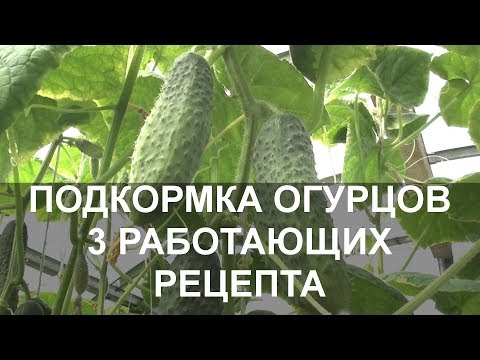

Watch this video on YouTube
Treatment
Cucumbers grown in open soil can often be affected by fungal diseases, so it is very important to timely carry out preventive treatments of bushes that will help increase their resistance to such ailments. There is an effective folk method that helps to increase the resistance of a given culture to various diseases. First, prepare a solution, for this, combine brilliant green or iodine with water in a 2: 1 ratio, then they are coated with the lower 10 centimeters of the stems of the bushes. If such processing is done in a timely manner, then the bushes will no longer need spraying with fungicidal preparations. In order to prevent rot, cucumber bushes must be treated with iodine solution (10 milligrams for 1 bucket of water).
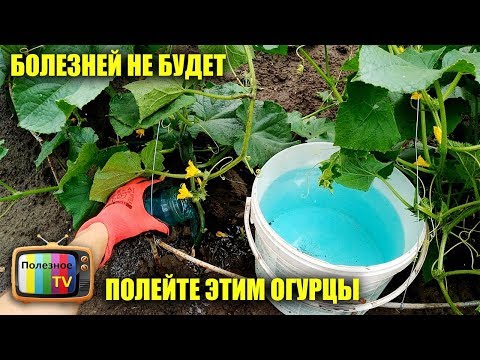

Watch this video on YouTube
Diseases and pests
Cucumbers can be affected by various diseases, and a variety of pests prefer to settle on the bushes. If you take care of this culture incorrectly, then the following diseases can strike it: anthracnose, bacteriosis, ascochitosis, verticillosis, powdery mildew (real and false), black leg, black mold, gray rot, olive and brown spots and ring mosaic. Also, pests such as aphids, root nematode, bear, scoop, sprout fly, tobacco thrips, spider mite and wireworm can settle on cucumber bushes. Slugs can also be very harmful to cucumbers.
To get rid of diseases or harmful insects that have affected such a vegetable crop, it is not recommended to use chemical agents, especially during the formation and development of fruits. There are many popular recipes that have been used for the treatment of cucumbers for a long time.
Collection and storage of cucumbers
The picking of cucumber fruits should be done as they ripen. As soon as the bushes begin to bear fruit, it will be necessary to collect the fruits at least 1 time in two days, otherwise the overgrown and yellowed cucumbers will complicate the process of forming young zelents. When picking the fruit, you need to pull out all those cucumbers that have an irregular shape. Harvesting often enough will encourage more new fruit to grow. As a rule, greens from 8 to 12 centimeters in size are canned, and fruits 8–18 centimeters in size are salted, and to prepare a salad, you can take cucumbers of a larger size. How often the harvest will be carried out will help regulate the number of zelents for the required purpose. For example, if you collect cucumbers every day, then greens suitable for conservation will grow very quickly, and if you collect them 1 time in a couple of days, then the number of fruits used for pickling will increase. When the first frosts pass, all greens will need to be removed from the bushes.
Harvesting is carried out in the early morning or in the evening, this should be done so that the stalk remains on the whips, in this regard, the greens should not be pulled or pulled, but cut off. If the fruit grows in the depths of the bush, then picking it off, you need to try so that the cucumber shoots do not overturn. Plucked greens should not be left in the sun, they must be immediately removed to a shaded place where it should be cool.
Such fruits cannot be stored for too long; therefore, many gardeners pick them up and preserve them, making supplies for the winter. However, if you adhere to special rules, then the greens can remain fresh for 7-14 days. So, they can be folded into a large saucepan, which is filled with water, where they can lie for up to 1.5 weeks. In this case, the pan must be tightly closed with a lid, also do not forget to replace the water in the container every day. Another way is to take the egg white and beat it a little, with the resulting mass you need to thoroughly coat the washed greens. Wait for the protein to dry and store the fruit. Cucumbers processed in this way can be stored for 7 days even outside the refrigerator.
If you have a summer cottage or live in a village, then such vegetables can be stored in a deep stream that does not freeze in winter. For this, thick-skinned fruits are placed in a barrel, which is immersed in running water. This will keep the greens fresh until approximately mid-winter.
Types and varieties of cucumbers with photos and names
Cucumbers have many varieties, which are divided by purpose into canning, salad and universal. Canned varieties include those in which the fruits have a thin skin and a high sugar content, and this is of great importance when pickling and pickling. In the greens of salad varieties, the skin is thicker and tough, it does not allow the marinade and brine to penetrate into the fruit. But such fresh cucumbers are more tasty than canned fruits. Zelentsa of universal varieties are used both for making salads and for pickling.
Popular canned varieties: Business, Brigantina, Rodnichok, Favorite, Voronezh, Zasolochny, Urozhainy 86, Reliable, Nezhinsky local, Competitor, Cascade. The most popular salad varieties: Adam, Graceful, Movir, Saltan, Phoenix, Parade, Synthesis, Rzhavsky local. Universal varieties: Stork, Epilogue, Marinda, Regia, Duet, Cruise, Crane, Farmer, Sagittarius, Moravian gherkin, Khabar, etc.
Also, all varieties are divided according to the ripening time:
- early - ripen in 32–45 days;
- average ripening - ripening lasts 40–45 days;
- late - ripening duration from 50 days or longer.
Early ripe hybrids and varieties: Lilliput, Graceful, Bully, Emelya, Zadavaka, Blizzard. Varieties of average ripening period: Picas, Athlete, Stepnoy, Solnechny, Unity, Far East 27, Competitor, Topolek. Late-ripening varieties: Nezhinsky, Phoenix, Khrust, Secret, Chinese climbing, Spring, Chinese miracle, Parisian, Mother-in-law.
Also, this culture is divided into hybrids and varieties. Hybrid cucumbers, when propagated by seeds, are not able to preserve the varietal properties of the parent plant. At the same time, varietal cucumbers retain their varietal characteristics even after several generations. However, hybrid plants yield much earlier and more abundant crops, and they are also stored for a longer time and begin to turn yellow much later than varietal cucumbers. In this regard, varietal cucumber seeds are much cheaper in comparison with hybrids. Popular hybrids: Buyan, Marinda, Othello, Parker, Regina, Pasadena, Business, Ajax, Brigantine, Herman, Emelya, Katyusha, Swallow, Faithful friends, etc.
Still all varieties of such a culture are divided according to the type of pollination into self-pollinated and bee-pollinated. Bee-pollinated varieties are used for growing in open soil, they include: Athlete, Zhuravlenok, Zastolny, Graceful, Lyubimchik, Slavyansky, Katyusha, Competitor, Casanova, Nugget, Swallow, etc. Self-pollinated varieties, also called parthenocarpic, are grown in open ground, and also in the greenhouse, these include such varieties as: Adam, Aelita, Stella, Juventa, Russian style, Romance, Picnic, Navruz, Marta, Pasadena, Voyage, Danila, Amazonka, White Angel, etc.
By the size of the fruit, they are divided into gherkins, reaching no more than 80 mm in length, as well as salad-type cucumbers, which are eaten fresh. The varieties bred by German breeders are related to gherkins, for example: Adam, Graceful, Othello, Libelle, etc.
The fruits are also divided by the nature of the surface into large tuberous and small tuberous. In this case, the thorns located on the surface of the zelents can be painted black or white. White-thorn salad varieties include: Emerald Stream, Chinese Snakes and Chinese Heat Resistant. Salting black thorn varieties: Nightingale, Real Colonel, Salting, Lilliput, Aquarius, etc.
Also, for exotic lovers, rather unusual hybrids and varieties were created, for example:
Chinese long cucumbers
The length of their shoots is about 350 cm, and the length of zelentsov is 40–90 cm. Such fruits have high taste, and the varieties themselves are high-yielding, unpretentious and very easy to grow. The following varieties are most popular: Chinese miracle, Chinese long-fruited, Chinese farm, Chinese white, Emerald stream, Lio Ming, Chinese disease-resistant.
Armenian cucumbers
They have an extremely unusual look. The length of ribbed greens is about half a meter, and their weight can reach 1 kg. They are covered with a whitish-silvery downy. Scourges can be up to 400 cm long. These varieties are suitable for growing both outdoors and indoors. Popular varieties are: Silver melon, Bogatyr white, Mel he Flehu-ozus.
Italian cucumbers
This group of varieties received such a name due to the fact that it was born thanks to Italian breeders. The appearance of such fruits is similar to the zelents related to Armenian varieties, so they have a ribbed shape. The color of the peel directly depends on the variety and is pale green, for example, in the Tortorello (Watermelon) variety, its taste at the same time is similar to cucumber and watermelon. Also, zelents can have a dark green color, which after a while changes to yellow-orange, for example, the Barrese variety, which has a watermelon flavor.
Crystal apple
In England, breeders were able to create an unusual hybrid, the fruits of which are very similar in appearance to lemons, but they taste like a simple cucumber. The scourge of such a plant can reach a length of 600 cm.
White cucumbers
Such varieties with long shoots are suitable for growing both outdoors and indoors. They are highly resistant to disease and heat. Very delicate fruits have a sweetish taste and are about 20 centimeters long, but it should be borne in mind that they outgrow extremely quickly. Popular varieties: Italian White, Snow Leopard, Bride, Snow White, White Angel, Three White Leaves.
Melotria rough (mini cucumber)
This decorative liana is a perennial, it comes from Africa. The foliage has a bright green color that remains unchanged until October. Zelentsy reach only 25 mm in diameter, outwardly they are similar to small watermelons, which have a cucumber taste. They can be eaten fresh, or used for pickling or pickling.
Momordica (Indian cucumber)
This cucumber is suitable for growing at home and in the open field. The leaves of the bushes are very effective. The flowers have a deep yellow color and a jasmine scent. Elongated bumpy greens are painted in a dark green color, which eventually changes to a deep orange. The ripe green leaf opens up and becomes similar to a crocodile that has opened its mouth, therefore it is also called "crocodile cucumber".
Trichozant snake cucumber
This pumpkin plant is quite popular in Southwest Asia. It is distinguished by its resistance to diseases and unpretentiousness. The length of the cylindrical fruits is 1.2 m, they wriggle like snakes. The color of the fruit is green, but over time it changes to orange. The flowers are similar to light snowflakes, reaching 40 mm in diameter.
Red cucumber tladiant dubious
This vine, which is native to Southeast Asia, is a perennial, its lashes are about five meters long. Heart-shaped leaf plates are greenish in color. The rich yellow flowers are similar in shape to tulips. Small fruits are suitable for pickling and pickling. However, fruits longer than 15 centimeters turn red and very sweet, and delicious jam is prepared from them.
Antillean cucumber anguria
On the lashes, reaching about 400 cm in length, watermelon leaf plates grow. Small fruits weigh about 30-50 grams, they have a cucumber taste, and they are used for canning. This cucumber is often grown as an ornamental plant.


Watch this video on YouTube

